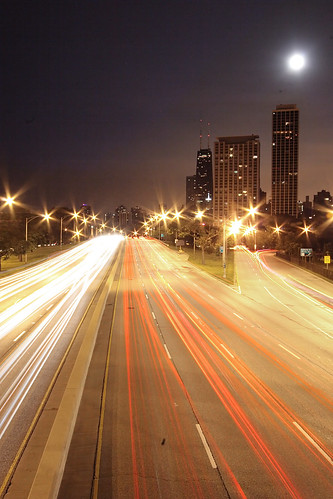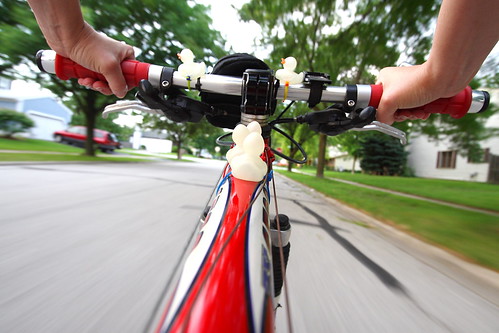Why you get blur:
Photos are made of light, it's as simple as that. You've seen photos that were too dark -they just didn't have enough light. And photos that were too bright -they had too much light. So, you can imagine that in bright sunlight it's easy to get enough light to make a photograph, but in dim light it's harder to get the same amount of light. The camera has a few different ways to increase the amount of light in your photo, but they are all limited, and eventually all it can do is keep the shutter open longer which effectively just means it takes longer to record your photo. If anything moves while the shutter is open (while the photo is being recorded) it results in blur.
I want to mention too that dim light is sometimes tricky to recognize because our eyes adjust so well to poor lighting conditions, but most indoor light is considered quite dim for photography and even an overcast day can result in blurry photos especially when shooting subjects that move fast like sports or cars or if you are using a telephoto lens or zooming in a lot.
How to avoid blur in dim light:
For Auto Mode:
Tripod: Like I said above, blur is a result of low light and movement. The movement can come from your subject (the people or items in your photo) or from the camera itself. If items that were not moving are blurred in your photo (tables, goal posts, etc) then at least some of your blur was coming from movement of the camera. This is easily corrected with a tripod. If you don't have a tripod you can set the camera on something steady or use one of these steady shooting techniques.
Use flash: Usually cameras will automatically use flash to try to increase the amount of light in the photo. This works well when your subject is within about 15 feet of the camera. So, make sure your flash is turned on. If your camera has a mount for an external flash you can look into getting a flash that has a higher light output to get a larger range or the flexibility to bounce the light off the ceiling or use accessories like diffusers to make the light less harsh than what comes out of the flash that comes with your camera.
ISO: Read your manual or look for a button or menu item that's labelled "ISO". It's possible that you may not be able to change it in "Auto" mode, so if you can't find it in the menu, try changing to "P" or "Program" mode instead (it's an Auto mode with a little more control).
ISO is a setting that controls how sensitive the camera's sensor is to light. When using lower ISO's like ISO 100 and 200 the sensor is less sensitive to light, but more accurate. With higher ISO's like 400, 800, or even 1600 and higher the sensor is more sensitive to light, but less accurate. If you are familiar with film at all, ISO is a lot like film speed.
So, the result of making the sensor more sensitive by setting the ISO higher is that your shutter speed (the amount of time your shutter is open) will be faster. When the shutter opens and closes faster, the chance of blur is less. ...so that's good! But, that "lack of accuracy" I spoke of earlier results in "noise" or a grainy or spotty appearance in your photo, so it's best to choose the lowest ISO possible for your shooting conditions.
Here's a general guide for choosing an ISO:
-ISO 100: bright sunlight (you can see well defined shadows on the ground)
-ISO 200: bright sun, but overcast (strong shadows can be seen, but their edges are fuzzy)
-ISO 400: overcast or bright shade (shadows are difficult to see or absent)
-ISO 800: dark shade or bright indoor light
I recommend grabbing your camera, finding your ISO setting, and taking some test shots at different ISO's to see the noise that results from higher ISO's and to see where that grainy appearance gets too bad for the photos to be considered usable. Every camera's different as far as noise goes, but noise is usually visible at ISO 400-800 and usually quite obvious at 1600 and above.
Try zooming out: Sometimes your camera can use a third setting called "aperture" to get a faster shutter speed. Sometimes the apertures your camera can achieve are limited when you are zoomed in on something. If possible you can try zooming out and getting closer to your subject instead to try to lessen the amount of blur that you are getting.
For Manual Mode:
Tripod: See the above advice on using a tripod or try some of these steady shooting techniques.Flash: See the above advice on flash.
ISO: See the above advice on ISO.
Aperture: When blur is an issue I tend to set my camera to aperture priority mode and set it to the lowest-numbered aperture that I can. Lower-numbered apertures (like f/4) allow more light into your camera than higher-numbered apertures (like f/20). Setting your aperture as low as it will go will ensure that you'll be using the fastest shutter speed you possibly can.
The lowest-numbered aperture available is determined by the lens you are using. So, if you need to get higher shutter speeds you may want to look into buying a "faster" lens. Typical lenses go down to about f/4, but "fast" lenses will go down to f/2.8, f/1.8, f/1.4, or even as low as f/1.0! Of course, the "faster" the lens, the more expensive! Canon and Nikon both make 50mm f/1.8 (non-zoom or "prime") lenses for between $100-$150. Because aperture also controls depth of field, these lenses will also give you a really shallow area of focus, so they are also great for portraits and other photography
Using blur creatively:
If you can't beat it, sometimes a little bit of blur can be a good thing...
It can show movement:
Here's a how to on this "panning" technique.
Or blur can be used for light painting:

Here's a how to on this "light painting" techinique.
Blur can look quite cool when there's traffic!

Or can convey motion:


No comments:
Post a Comment